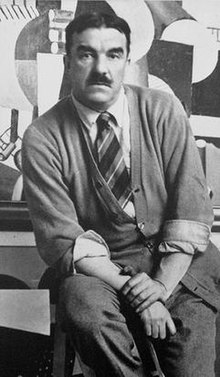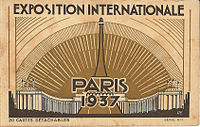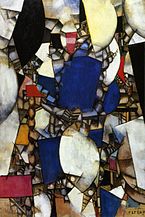Kimbell Art Museum
You might be familiar with this vibrant sculpture from the Kimbell lawn, but how well do you know the artist behind it?
Fernand Léger, born on this day in 1881, was both a sculptor and painter. He began to explore work in ceramic sculpture later in his career, when he returned to his native France after World War II.
Léger was profoundly interested in modern technology and deeply invested in bringing art to the public. After his return to France, Léger expanded his interest in public art, embracing new media—mosaics, textiles, and stained glass among them.
It was during a trip to the town of Biot that the artist began creating ceramic sculptures. “Walking Flower” was one of the products of this burst of creativity. The sculpture, boldly colored on one face, black and white on the other, is a form from nature imbued with a humanlike spirit of humor, play, and joyfulness.
Happy birthday to Léger! See this ceramic sculpture on the Kimbell Lawn.
___
Fernand Léger, “Walking Flower (La fleur qui marche),” 1952. Kimbell Art Museum


National Portrait Gallery
'If pictorial expression has changed, it is because modern life has necessitated it,'
Artist Fernand Léger was born #OnThisDay in 1881 in Argentan, France. Throughout his career, Léger drew inspiration from the dynamic and ever-changing shifts of modern life. In 1908, he joined the colony of artists La Ruche (The Beehive) and developed a semi-abstract style, breaking down forms into tubular shapes. After serving in the First World War, his work incorporated more geometric and mechanised forms. He experimented with media, from painting and muralism to illustration and film. As a teacher, he influenced the next generation of leading artists - Louise Bourgeois, William Klein, Saloua Raouda Choucair, and Marlow Moss, who all graduated from his classes.
 Fernand Léger by Francis Goodman, 1950 © National Portrait Gallery, London
Fernand Léger by Francis Goodman, 1950 © National Portrait Gallery, London
Fernand Léger (1881~1955 ):建築、藝術與他;眾生參訪1937年巴黎万国博覧会。論紀念性與色彩 On Monumentality and Color 約1943~1953? 天主教堂藝品奉獻 France: The Sacré-Coeur, Audincourt 1951。家庭開車鄉間遊Country Outing
https://www.facebook.com/hanching.chung/videos/611084200037280
Fernand Léger | |
|---|---|
 Fernand Léger, c. 1916 | |
| Born | February 4, 1881 |
| Died | August 17, 1955 (aged 74) Gif-sur-Yvette, France |
| Nationality | French |
| Known for | Painting, printmaking and filmmaking |
| Movement | Cubism Modernism |
建築與他
Léger was born in Argentan, Orne, Lower Normandy, where his father raised cattle. Fernand Léger initially trained as an architect from 1897 to 1899, before moving in 1900 to Paris, where he supported himself as an architectural draftsman.
立體主義
純粹藝術
柯比意 1925 1926
****眾生參訪1937年巴黎万国博覧会
 | |
| イベントの種類 | 2種一般博 |
|---|---|
| 正式名称 | パリ万国博覧会 |
| 開催時期 | 1937年5月25日 - 11月25日(6ヵ月、185日間) |
テーマは「近代生活における芸術と技術」(Arts et Techniques dans la Vie Moderne) 。
*****
On Monumentality and Color 約1943~1953?
Harvard University Press has partnered with De Gruyter to make available for sale worldwide virtually all in-copyright HUP books that had become unavailable since their original publication. The 2,800 titles in the “e-ditions” program can be purchased individually as PDF eBooks or as hardcover reprint (“print-on-demand”) editions via the “Available from De Gruyter” link above. They are also available to institutions in ten separate subject-area packages that reflect the entire spectrum of the Press’s catalog. More about the E-ditions Program »
Here, the famous author of Space, Time and Architecture and other books examines basic principles of architecture—as handmaiden to essential shelter and comfort, and as creative partner in the aspirations of the human arts.
Sigfried Giedion is a man with clear vision and proven ability to communicate his ideas on the interrelationship of architecture and society through the ages. He is able to explain what remains from the past in every city of today—how the Greeks, the Romans, and the later peoples still influence our life through principles of city planning. Equally, he is able to see how men like Le Corbusier, Sert, Mondrian, and Léger have transformed our living quarters so that they are increasingly useful, practical, and attractive.
Giedion discusses the constant need for and striving toward monumentality in the architecture and cultural development of today. Leading us through paths which all too often seem bewildering, he helps us to understand ourselves better through helping us to understand our entire cultural heritage.
One of the author’s most important contributions in this new book is his concern with imaginative development of space utilization in relation to the building of new theatre and institutional groups, to the Sydney Opera House, the Boston Back Bay Center Project, and to the new center designed for Marseille by Le Corbusier—in short to the climate of creative living in many parts of the world.
天主教堂藝品奉獻
France: The Sacré-Coeur, Audincourt 1951
****
In 1960, the Fernand Léger Museum was opened in Biot, Alpes-Maritimes, France.
In May 2008, his painting Étude pour la femme en bleu (1912–13) sold for $39,241,000 (hammer price with buyer's premium) United States dollars.[26]
Léger's work was featured in the exhibition "Léger: Modern Art and the Metropolis" from October 14, 2013, through January 5, 2014, at the Philadelphia Museum of Art.[28]




沒有留言:
張貼留言